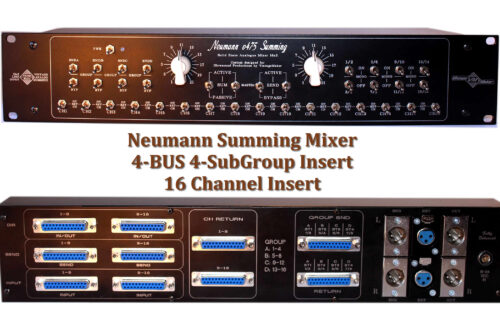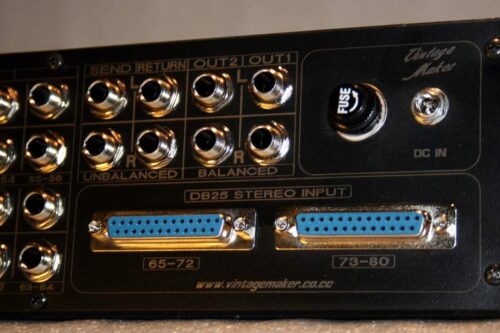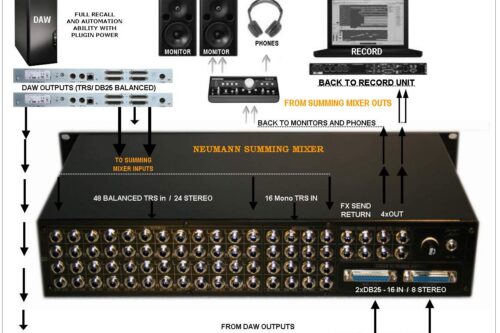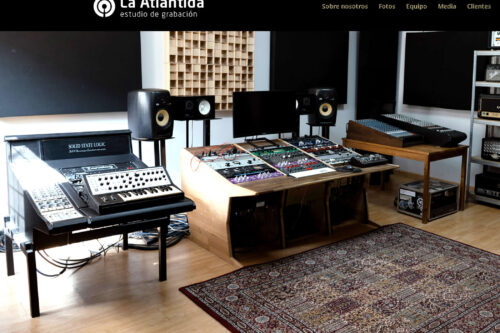
Summing Mixer Reviews Customer Feedback
JURIJ GIANLUCA RICOTTI – Multi Grammy Nominated Productions – Warner Bros – Universal Pictures – Sony
Awarded with Dubai Lynx 2015 for best Music and Interactive. Awarded with Effie 2015 – Mix process with the best sound engineers worldwide in full analog system in Los Angeles, Rome and PPG Studio – read more about JGR Productions

JGR Studios awarded on hundreds albums with
Andrea Bocelli, Ennio Morricone, Beyoncé, Pink, Ariana Grande, Kevin Costner, Britney Spears, Steven Mercurio, Rita Ora, Kacey Musgraves, MIMS, Queen, David Sylvian, Malmsteen, Steve Vai, Macalpine, Bireli Lagrane, Salvatore Russo, Il Volo, Fernando Osorio, Ana Belen, Armando Manzanero, Richard Galliano, Marcello Giordani, Ron, Renga, Chiara Galiazzo, Vinnie Colaiuta, Nathan East, Michael Thompson, and many others.
Neumann Summing Mixer with – Active | Passive – 2in1 option
I should firstly like to say something in defence of my VM Mixer, Vintage Maker is my best choice for sound engineer wants a real analog mixer with custom components.
In my experience, Mostly of peoples aspect a sound “changing”, “colouring”, and other artefacts make their mix more Big, Huge and Powerful than digital summing process. Mostly of the peoples don’t know what analog summing means.
Let me explain the differences:
- Digital summing is a mathematical computer processing that loses all the phase characteristics added in the analog mixer.
- Analog summing combines the original tracks in the original format with all the transients and harmonics.
Regardless of whether we are talking about a passive or active mixer. That’s the principal feature. A Passive or Active or both 2in1 summing should be the best situation and the real feature we need in the digital world.
What I appreciate most about the VM mixer
is its ability to preserve the original sound while adds huge harmonic content; unlike many other mixers, it doesn’t alter the audio. I can easily distinguish music mixed on a Neve mixer from a distance due to its distinctive Neveish sound….There’s nothing wrong with Neve, which is great and superior gear but not as crystal-clear transparent as the VM Neumann summing; I just don’t like that all my music sounds monotonously similar.

Neumann Analog Mixer
The analog mixer retains all transients, harmonics, or other pleasant harmonics to the human ear
which occur when higher volume reaches the inputs of the summing especially the summing circuit (which is a passive resistor network), nothing extra, just simple physics (though many people may not know). The second step is that you can use your own DAW mic preamp ins, or other external microphone preamp, or if you have an active summing mixer like my Neumann v475, you can use that (on its own or in combination woth daw mic pre or other). With this, you further excite and add a spatial harmonic subtle saturation layer to the existing harmonics (which were generated earlier in the passive summing circuit).

JGR Production Studio
VintageMaker is a piece of gear of my entire process.
As explained, the main difference is the 3D spatial effect created with phase summing in analog world, and this difference is more evident with huge tracks summing of course.
8 tracks summed in analog sound much better than digital summing
and certain software like Harrison Mix Bus makes a great virtual summing more than Protools, Cubase etc. 16 Tracks summed in analog are more wide than 8, and 24 tracks are incredibly wide and beautiful than only 8 summed. So it is indeed true that its analog capacity is almost infinite. But…. in this process someone forget the tools between the gear. DA converters are an important part in this process. The DA conversion is very different than AD. Choose the best converters makes a huge difference in the analog summing. I’ve tested a lot of converters before my final choice Ferrofish, Creamwear, Behringer with and without customs components, Apogee, etc. here is my basic setup signal flow with VM summing box
Ferrofish and VintageMaker Summing box seems to be my best “clean” choice.
Another factor to consider is the Word Clock, and professional audio board than clock all the tracks and clock the DA, without WC synch these machines makes difference on the process too. And Last but not the least, the cables. Pro means pro, if you want use pro gears you have to choose pro cables. I’ve chooses Vovox cables connected from my DA to VM and viceversa from VM to my audio board (RME UFX) for the bounce recording, another more economic choice could be Cordial. That’s make the differences, i’ve listened some one says analog summing does not make difference, bla bla. I’ve seen people love summing gears change the sound of their mix thinking to colour the mix. If your choice will be colour the mix, just test different summing box until you will find the right one for you, but please don’t say this summing is better than this etc etc. If you want color use some nice Equalizer with built in transformer… Have no sense, even you choose a preamp for your gear, in the same question. Avalon is better than Neve and bla bla.

Movie Soundtracks Production
A quick tutorial for clear understanding because many don’t understand it, although it’s really simple.
I have VM mixer with Active/Passive switch, It’s like having two different mixers in one box, so I can use it in many different ways. If you have a simple passive mixer, use different preamps or preamp emulation plugins like UAD Unison or others. I also sometimes use the passive mode, taking advantage of the benefits of pure analog summation.
- Passive: DAW Interface OUT—>MIXER IN—>[Passive Summing Circuit]—>MIXER OUT—->DAW Interface Preamp IN – —>Record
- Active VerA: DAW Interface OUT—>MIXER IN—>[Passive Summing Circuit]—>[Neumann Transformer]—>MIXER OUT—->DAW Interface IN—>Record
- Active VerB: DAW Interface OUT—>MIXER IN—>[Passive Summing Circuit]—>[Neumann Transformer]—>MIXER OUT—->DAW Interface Preamp IN—>Record
- *as you can see, with these variations, you can already achieve three different sound characters
First, i suggest to learn how to mix in analog, understand the principles, and then use various preamps after summing to get different color character.
Simply send your track at a higher volume from the DAW interface to the summing inputs. (that’s the goal). Don’t be afraid because the analog headroom protects your tracks from distortion (unlike digital). Additionally, due to the higher volume, an extra pleasant analog distortion is created in the passive mixer circuit at the input of the mixer. Then, readjust the positions of the instruments in the stereo field. Each one will have a better place, sounding much cleaner, more separated, and with more character in the mix. Then, add some gain to your preamp inputs and record.
I generally work in studio with Neve and SSL, with master sound Engineer like Humberto Gatica etc.
*Humberto Gatica – recording engineer, mixing engineer and record producer, best known for his work with Celine Dion, Chicago, Michael Jackson, Barbra Streisand, Andrea Bocelli, Josh Groban, Cher and Michael Bublé
When I want produce some in my personal home studio or simply Mix and Master with my gear…. Vintage Maker makes me happy because is transparent with extra huge harmonic content. When I want a touch of color, I pull up the Active section with Neumann 475-2B, of course, v475-2C can perform the best too, but I choose the 2B because I really like the rarities, and the 2B is the rarest, best-sounding Vintage German transformer.
IMHO Analog summing makes huge differences
especially in Rock – R&B – acoustic recordings or modern genres, it also produces superior results, but in other situations like Dance, and Electro you could choose agains the analog summing, will be better than digital….. before speak about VM performances, just check your outboard gear before, cables, and DA….. I hope could be useful for the next analog summing users.
Here’s an Italian tutorial; I hope it will be useful for Italian producers.
NIKO SCHAUBLE – Award-Winning Drummer, Composer, Producer, Audio Studio Engineer
Professional recording studio in Melbourne, Australia, producing more than 160 albums to date. Read more about Pughouse Studios
Niko has performed with many of the world’s leading artists including Wynton and Branford Marsalis, Sam Rivers, Lee Konitz, Dewey Redman, Enrico Rava, Greg Osby, Arthur Blythe, Palle Mikkelborg, Paul Grabowsky, Trilok Gurtu, Karaikudi R. Mani, Deborah Conway and Archie Roach. His work as a musician and composer is documented on over 60 albums.
Guess that tells you how happy I am with the units…
I, too, find that using OTB summing makes a subtle, yet remarkable difference, especially in regard to clarity of position in the stereo field (and mono is true mono). I love being able to create sub mixes/stems using the smaller summing mixers and running them through a variety of preamps for colour (or non-colour).
My clients love it, too, and many returning customers ask/demand for the mix to be run through the analog summing mixer/s. I even have clients coming in because of this equipment (one particular client did his own research and came because of the VintageMaker brand; that job alone paid for the units several times over…).

I even have clients coming in because of this equipment.
I’m pretty intimate with my outboard gear and my setup allows me to utilize them efficiently to color a track in accordance to what it might need.” Indeed so. The artistry of Niko Schauble of Pughouse and his collection of vintage outboard EQs, compressors and preamps was exactly what I needed. I figured since I had already put in this much work, Niko’s warm boxes would be icing. The exported tracks from Singapore were imported into a ProTools station. Some of the reverbs were replaced with Sony Oxfords and Lexicon Native. Niko’s suggestion of using Sound Toy’s Echoboy turned out to be what some of my vocals needed for that slight touch of glimmer in the mix.
I bought two units several years ago: a Neumann 24/4 and, since then, another four Dual 8/2 (16) channel passive summing mixers.
Just had an enquiry for 5 days mixing, running stems through analog summing…
The signal path went from the playback machine (ProTools) through an Apogee Symphony, into a Neumann Vintage Maker Summing Mixer
and then out to a second system via an Apogee Duet (which essentially has the same converters as the Symphony) and was recaptured at 24 bit 96 kHz. This process was recommended by Joel and accommodated by Niko who actually went out and bought another Apogee module for my session! On the heavier tracks, we also ran through a pair of Neve 51 channel strips post summing mixer and the cleaner tracks were run through the Earthworks 1024. On the whole, I was pretty ecstatic about how the mixes turned out, punchy on the tracks that needed to be and shimmery on the cleaner acoustic ones.
I have always been reticent to use descriptions like “wide” and “deep” but what can I say?
The Vintagemaker made my mixes sound “wider” and “deeper” and dare I say, there was a certain “sweetness” that in-the-box mixing does not give you. So the colors available though analog summing did shine through in the end (although mine was more of a hybrid mixing process) and if you’ve spent substantial time and effort tweaking your mixes as I have, it might behoove you to visit a studio like Pughouse for what I’d like to call “post-processing” before your down mix.”
Lastly, in regard to value for money and communication (Paul will discuss and build to your requests): I can’t recommend VintageMaker highly enough!
Fabrizio Egger – Glowsound Productions – 4-BUS Mixer (Switzerland) 2020
National and International chart hits, earning platinum awards for his work as a music producer read more about: www.glow-sound.net
I can say without a doubt that the sound quality of the Vintage Maker summing mixer places it in the Neve/API/SSL league.
Paul built me a 16-channel summing mixer with features you won’t find in any other analog summing mixer on the market:
- 8x stereo or 16x mono inputs (switchable), including inserts (switchable) and direct out
- 4 stereo subgroups incl. inserts (switchable)
- Neumann V475 summing amp with a switchable master insert and the possibility to switch to passive summing.”
Pro Tools HD Native with Avid HD 16×16 converter. I set up the stem outputs right in the beginning and mix into the VintageMaker summing mixer:
More analog gear for the inserts to come!
Since I’ve been mixing with the VintageMaker and my analog compressors, I get a better mix in half the time than before with plug-ins alone. So yes, analog signal processing and summing really makes a difference.
80 Channel Summing Mixer – PlethoraTone Music Studio – Nashville, Tennessee
I auditioned a number of summing mixers over the years (SPL, Dangerous, Neve, and others), but this is the one that I chose to keep because of its outstanding sonics – I believe it’s wonderful sonic properties of the Neumann v475 that I’m drawn to. Paul Taylor of VintageMaker is a real gentleman and his summing mixer are enjoyed by a lot of folks in the audio community.
Let me introduce another one of PlethoraTone’s audio secret weapons:
The amazing VintageMaker Neumann v475 stereo summing mixer. There’s an incredible total of 80 balanced line-level inputs – 24 TRS stereo pairs (48 total inputs), 16 mono TRS inputs, and two DSUB inputs with 8 channels each (16 total inputs). Via this configuration we were never short-changed, and the results were effective when using as few as 8-stereo channels, as well.
Our day to day studio configuration for years used the 24 1/4” TRS stereo pairs and all 16 DSUB inputs – these were connected via a normalized patchbay to the outputs of our 64-channel Pro Tools HD rig. It was a wonderful option, and you’ll enjoy the VintageMaker, too. This cornucopia of analog inputs are passively summed together and then routed into the amazing Neumann v475 duale stereo transformer summing amplifier. Input and output transformers from Haufe all within a gorgeous sounding Neumann gain stage create a depth and sonic detail that “glues” mix together.
The master L/R insert is the perfect place for a buss comp, EQ, and any other analog processing you want to strap across the stereo buss. Beautiful front panel controls provide the elegant and simple interface for sculpting great mixes. A pair of balanced stereo outputs is a nice addition for monitoring and recording audio paths, too. Mark at PlethoraTone – read more at plethoratone.com/
Patrick Schneider – Composer – Switzerland
Since 2020 I’m using a Vintage Maker 16 Channel active Summing Mixer with a v475-2C Neumann Amp.
For many years I was composing and demo mixing all tracks in a Box with an active Monitoring. After working with Producers in Los Angeles using SSL Consoles, I was convinced to re-design my compositing environment for analogue Summing. One big challenge was to find an affordable read more….
32-Ch Multi-Bus Matrix Mixer – The Continuum Music Studio – Sacramento, CA
Conscious mentorship & professionalism in recording, song writing, production, mixing, mastering, personal growth, & self realization through music
Paul is the owner of VintageMaker – and one of the most passionate people we have ever done business with inside the small pro audio world.
Paul has an extensive knowledge of gear and has been making custom summing mixers to order for years. Paul offers options and customization that no other company (to our knowledge) offers. Not to mention the VintageMaker summing mixers can be made with both active and passive circuitry along with other flexible options which makes these summing mixers a no brain for any producer or audio engineer.
The VintageMaker products offer a very clean, 3d and transparent sound. The units are handcrafted with extreme care and are laser engraved. Overall, the VintageMaker units are damn classy looking units! These units do not just look pretty though, the sound dynamite! Separation, clarity, width, and so much more. What’s not to love when it comes to taking an ITB mix and turning into that open and pristine analog console sound!
24-Ch Matrix Mixer – La Atlantida Estudio (Spain)
Atlantida Studio has recorded more than 150 records and boasts a large team capable of accommodating various productions and musical styles. In addition to recording and production, the studio also provides services for advertising, television, and backline rental read more about….
Specs:
- 3U Standard Rack
- Neumann v475-2B NOS
- 24 inputs via DB25, resulting in 12 stereo channels
- 2x Stereo outputs via balanced XLR as OUT1/OUT2
- 4x Stereo to mono channels (CH1-CH4) or 8 mono channels, switchable with a master sum bus switch
- Active/Passive 2-in-1 functionality via the front panel switch
- Master Send/Return controlled by the front panel switch
- 12x Stereo Insert/Return, switchable via the front panel switch
- 12x Stereo Insert/Return via 3xDB25 for send – 3xDB25 for return
- Group selection: ABCD or Master sum, switchable
- ABCD subgroup send out controlled by 4x volume control via TRS balanced
- ABCD Send/Return via TRS balanced
- 48 stereo routing switches (12×4) for A/B/C/D selection
- 2x 21-step precision Neumann master gain potentiometer
Hi Paul! The summing mixer sounds really really good! Lots better than my ssl analog board! Thanks!
You did a great work!! Best. Mario Patiño
Joe4Sho @Effortlessmusic
When I first went down the analog rabbit hole I came across the main stream summing mixer‘s Dangerous D box and Shadow Hills Equinox, but when I dug deeper I found the gem Vintage Maker.
From that point on, I knew and visualized in my mind what I wanted to do, and for the price, I couldn’t beat it.
I started with the little passive summing mixer, the 16-box, just to get a feel for what the summing boxes can do. My entire analog setup was built around that little box—a hybrid setup with Studio One and the Quantum 4848, where the 16-summing mixer, along with the Neumann 475–2 summing amp, fits perfectly. The best part, for me, is the headroom.
While I know there are many things you can get out of the summing mixer, headroom was the most important to me.
Having the flexibility to bring it down a little and sculpt the sound with EQ, compression, and tape is crucial. Paul is a good guy; I value his opinion.
When I told him what I wanted, he explained the differences in the amps
gave suggestions, and in the same sentence said, “I’ll build you whatever you want.” I highly recommend Vintage Maker for your summing mixer needs.





































